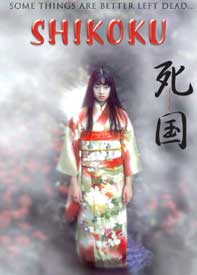Based on a bestselling Japanese horror novel, Shikoku is set on the titular island in a rural village. Toshie Negishi as the last lineal priestess of Shinto animism & spirit worship has lost her only daughter, hence the centuries-unbroken lineage has come to an end. She sets out upon a sixteen year ritualistic pilgrimmage that will result in the opening of the gate of Yomi (the Netherworld) to release her daughter Sagori in the form of a tragic demon. This is an obviously harmful plan, but the old priestess is out of her mind, & pursues her objective with singleminded madness.
As the story opens, it is the sixteenth year of the priestess's insane quest, & two of Sagori's childhood friends, now grown, attempt to stop the opening of the hell-gate. The first two thirds of the tale are told in a quiet moody manner, gorgeously filmed in an actual rural village on Shikoku, so that there is visual grandeur to the setting.
The bulk of the film depends on the performances of Yui Natsukawa as Hinako whose life was saved by Sagori when they were little, & Michitaka Tsutsui as Fumiya who was Sagori's childhood love. Michitaka especially is a very appealing actor, but there is not a great deal of strength in the story of how these two characters fall in love while investigating the haunting. It is the actions of the priestess, always a shadowy sinister figure in the story's background, & of the ghost herself, that make the film interesting.
The extended climax hinges on the performance of first-time actress Chiaki Kuriyama as the unhappy & jealous spirit of Sagori, who must be played by turns as heartbreakingly tragic, & demonically dangerous. This young actress is uniquely beautiful, just odd enough to have been great casting as a ghost; her physical presence in the film holds viewer attention with very little effort. Her acting skills per se are not the best-honed that the film offers, but it was a difficult role to pull off, requiring her to be simultaneously a muderous demon & a sorrowful young girl. She in the main succeeds, but the portrait & therefore the film is not flawless.
The climax gets a bit "busy" trying to tie up too many loose ends, adding a Buddhist priest to the climax who had not been a major character until then, dragging out Sagori's misery-laden monologues a mite redundantly, & requiring an apparent sacrifice which is not presented very credibly but after all the delays seemed to have been photographed with slipshod haste. It needed tighter editing to have serious impact, & the sacrifice needed a visually better context.
The ending is less skillfully constructed than the first two-thirds of the film, but it's all fairly effective even with its climactic faults.
As an aesthetic & eerie ghost story with a classic-cinema attitude void of the kitschiness of most of the modern Japanese horror films, Shikoku is much above the average for supernatural cinema. A viewer looking for horror shocks may be disappointed, but someone interested in an atmosphere of gloomy weirdness will be rewarded.
copyright © by Paghat the Ratgirl
|
